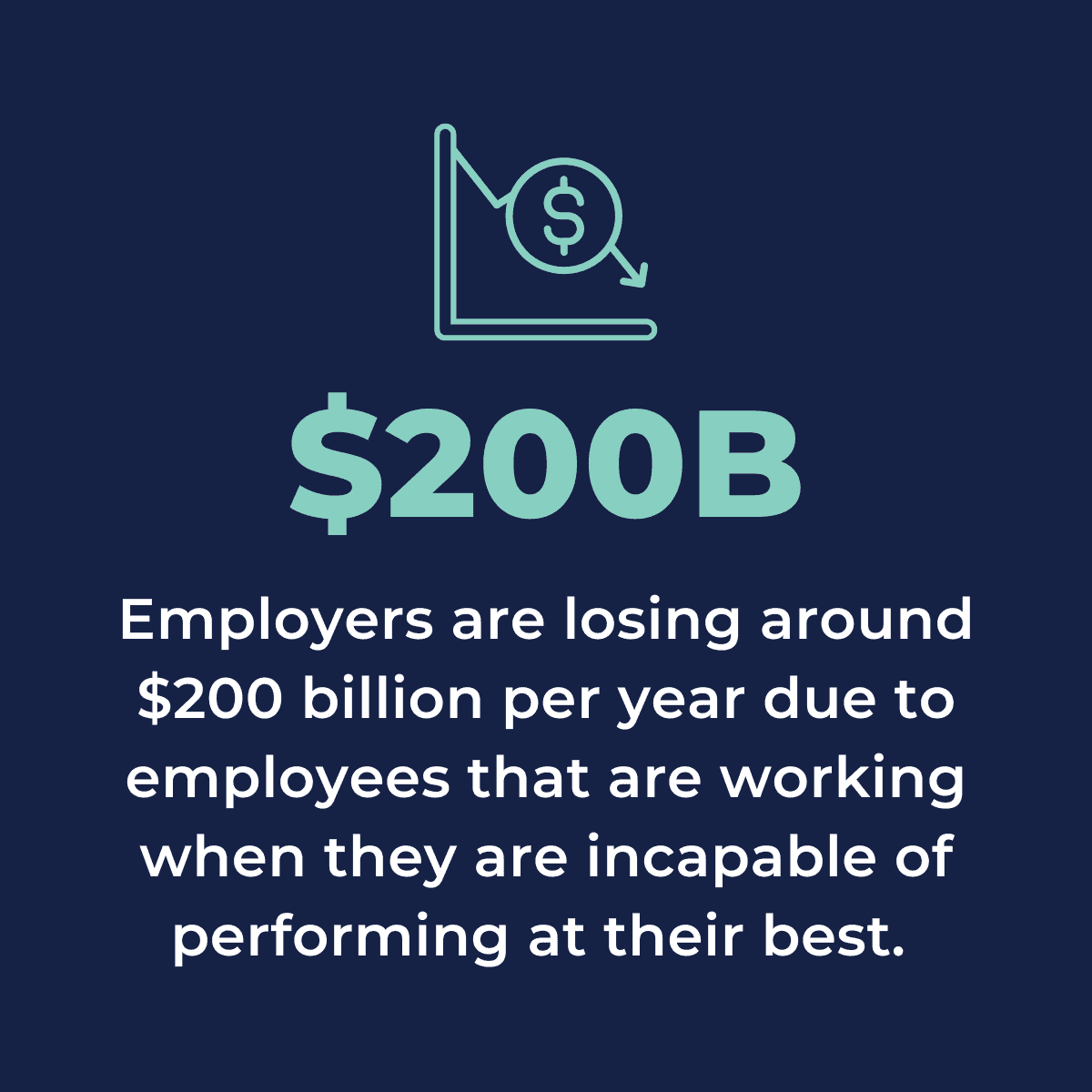The Effect of Poor Health on the Workforce
Every year, nearly $1 trillion in earning potential is lost by American corporations as a result of the poor mental and physical health of employees. When employees face mental or physical hardships – such as being sick, facing personal conflicts, or experiencing burnout – their focus is reduced, which significantly impacts the productivity and engagement of their team and organization.
There are two primary factors resulting in a loss of productivity: absenteeism and presenteeism. The annual cost of absenteeism – or employees missing work – across the nation totals $225.8 billion or about $1,685 for each employed person. Less apparent is the effect of presenteeism, which occurs when associates attend work but underperform due to being mentally or physically unwell, which totals 60% of illness-related expenses.
Now more than ever, employees are working when they are incapable of performing at their best, causing employers to lose around $200 billion per year. Along with missed revenue, this also affects the morale of staff that may struggle to keep up with demand as team members continue to work inefficiently. Overall, there is much work that needs to be done in order for companies to proactively support all of the initiatives necessary to create a physically and psychologically safe environment in which all employees feel included and as though they truly belong.

How Coaching Can Support the Five Elements of Workplace Well-being
According to a recently released U.S. Surgeon General Report, there are five integral components to creating a workplace centered around well-being: protection from harm, connection + community, work-life harmony, mattering at work, and opportunities for growth. The task of establishing an environment of well-being can be a massive undertaking, which is why bringing in coaches who are experts in the specific areas outlined can help companies reach a developed sense of workplace wellness more quickly and efficiently. Let’s break down each of the components and explain how coaching can support the fulfillment of these standards in organizations.
1. Protection From Harm
Described as:
- Prioritizing psychological safety
- Supporting psychological health
- Establishing DEIB policies and programs
How coaching can support:
- Encourages communication, transparency, and vulnerability, which aid in building trust and interpersonal risk-taking
- Establishes an equitable way to ensure all employees have access to development opportunitie
2. Connection + Community
Described as:
- Fostering a culture of inclusion and belonging
- Creating relationships of trust
- Pushing collaboration and teamwork
How coaching can support:
- Engrains communication and feedback tools that allow everybody to feel heard, involved, and valued, generating an environment of community
- Inspires teams to work together and innovate via group coaching workshops and breakout sessions
3. Work-life Harmony
Described as:
- Allowing autonomous task-completion
- Offering flexible and predictable schedules
- Honoring boundaries
How coaching can support:
- Gives employees the skills to self-manage, prioritize, and complete tasks efficiently
- Co-creates healthy boundaries with employees and teaches leaders the importance of respecting those boundaries, whether related to time off requests, workload, schedules, etc.
4. Mattering at Work
Described as:
- Including workers in decision-making
- Offering continuous gratitude and recognition
- Aligning people’s vision with company mission
How coaching can support:
- Supports the creation of a psychologically safe work environment where brainstorming comes from employees at all levels and positive and constructive feedback are valued
- Helps employees uncover parallels between their personal goals and values and those of the organizations they work for, inspiring passion and creating fulfillment
5. Opportunities For Growth
Described as:
- Giving high-quality training and guidance
- Devising clear, equitable plan for professional mobility
- Providing appropriate, reciprocal feedback
How coaching can support:
- With years of personal and professional experience and education from well-respected coach development programs, coaches are qualified to provide the training employees need to prioritize their wellness and show up stronger in their personal and professional lives
- Educates leaders on unique ways to map out employees' careers based on their individual strengths, interests, and capabilities. When coaching is provided to all individuals, it creates an equitable opportunity for professional growth
- Establishes a commonly understood framework and language for feedback conversations, making communication clearer and less emotionally-charged
Wellness directly impacts the prosperity, innovation, dedication, and fulfillment of employees. Investing in the health and happiness of your people will ultimately benefit your company’s bottom line, as these individuals will show up stronger, commit to your organization long-term, and drive the success of themselves and their teammates. Thankfully, employee coaching programs can guide organizations in their wellness-related efforts by establishing support, helping individuals find professional meaning, and driving the development and achievement of employees. Additionally, coaching helps establish an equitable workplace centered around collaboration, showcasing to all employees that their opinions are heard and valued. These actions are all integral ways for organizations to aid the long-term health and well-being of their employees and their companies.
